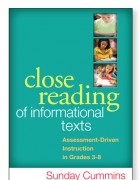
When you write a book, you never know how readers will perceive your ideas. I hoped my book Close Reading of Informational Text would be a way to start a conversation – with me and with your peers. Well, Meghan, a reading specialist in the western suburbs of Chicago, quite literally took me up on this offer to have a conversation and we have been corresponding by email about shifts in her practice based on what she has gleaned from Close Reading. I asked Meghan if she would share her thoughts and ideas with you, the readers of this blog, and she quickly agreed.
So an interview of sorts…plus some great resources Meghan developed based on the Close Reading. Thank you, Meghan!!!!
Sunday: As you read Close Reading, what questions did you begin to ask about your practice? What kinds of shifts in your instruction did you explore?
Meghan: As I read your book, I questioned many things about my practice. I have definitely had to shift some of my teaching. As a Reading Specialist, I have always taught the reading comprehension strategies and always ended with synthesizing because it always seemed to be the hardest to teach students and was always listed at the end of most documents that I have seen. After reading the book, I realized that synthesizing should be taught first. It works so much better.
I also used to focus on the elements of non- fiction and always taught SCAN and RUN, I know use the items elements [Features Commonly Found in Shorter Texts] on pages 82-83 [Table 4.1] from the book. These are a lot nicer and I incorporate them into all lessons when using non-fiction texts. I have realized that the simple analogies of the “Baking a Cake,” “Picture Frame,” and “Making Pasta” give concrete examples for students to follow. I then created the graphics for the students. These graphics help students to determine important information in a text and identify the author’s central ideas.
Sunday: What did you notice about your students as a result of these shifts?
Meghan: As I started to teach the lessons for close reading, I noticed many changes in my students. They are now able to determine important information from a text and orally discuss and write about this information. When I taught the lesson about the “Making Pasta,” I created a graphic for them (Determine Importance-Pasta Graphic) and it was amazing how students were more able to determine important information and then able to write a summary based on that information. Students had greater difficulty with this activity before the lesson. When teaching a lesson on synthesis and the “Picture Frame” analogy, I also created a Synthesizing Frame Graphic and a Frame- Notes Page. Students were able to accurately synthesize information and identify the author’s central idea. When teaching any of the lessons, I frequently referred back to the graphic that I created and also had it posted in the classroom. I also did the gradual release of responsibility. I do-We do-They do.
In the next post, I’ll be sharing some of the instructional artifacts from Meghan’s gradual release of responsibility.
Meghan – Thanks for bringing the ideas in my book to life!
